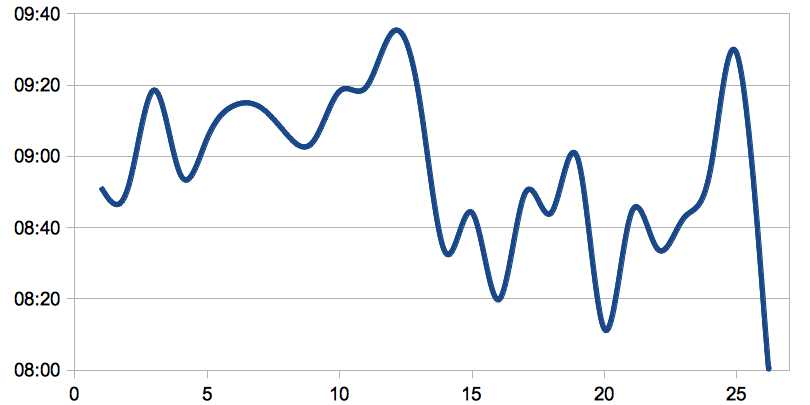^zhurnaly 0.9904

Howdy, pilgrim! No ads — you're in volume 0.9904 of the ^zhurnal (that's Russian for "journal") — see ZhurnalyWiki for a Wiki edition of individual items; see Zhurnal and Zhurnaly for quick clues as to what this is all about; see Random for a random page. Briefly, this is the diary of ^z = Mark Zimmermann ... previous volume = 0.9903 ... complete list at bottom of page ... send comments & suggestions to "z (at) his (dot) com" ... click on a title link to go to that item in the ZhurnalyWiki where you can edit or comment on it ...
RSS
~50 miles @ ~15 min/mi
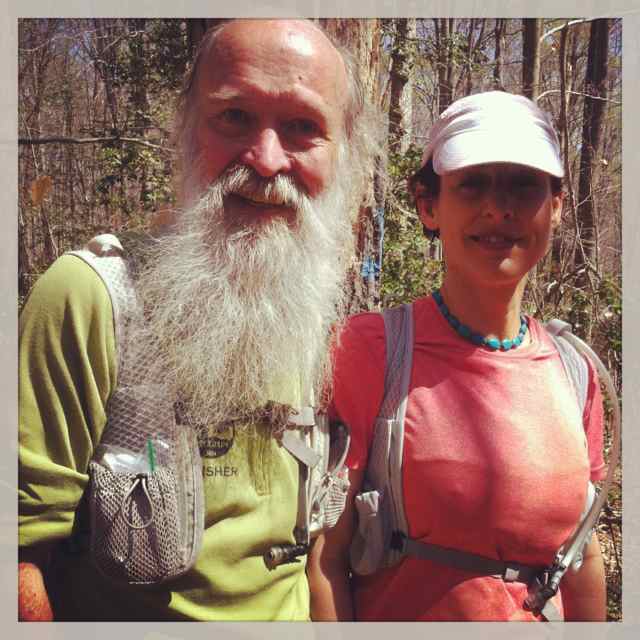 | Bottom line: 12 hours 29 minutes for my sixth BRR, accompanying audacious Dr Stephanie Fonda who finishes strong in her third and toughest ultramarathon. It's also her best ultra, with steady progress throughout and far fewer problems with feet, knees, digestion, blisters, etc. than on earlier long treks. Perhaps the mini Heath Bars that she consumes every 5-10 miles are the secret? Or maybe smart training, proper hydration, meticulous electrolyte management, and conservative pacing? Or is it, as Stephanie promises during our previous long training run "I'm doing something new at Bull Run. I'm not doing anything new!" — so credit goes to no wacky experiments this time with new shoes, new stride, new foods? (It certainly isn't my nonstop monologue, eh?) But on the Thursday evening before BRR I manage to break one of own my cardinal rules, "Protect your feet before a big event." Foolishly barefoot at home in the dining room, I brush my right foot across the hardwood floor and get a splinter in the sole — yow! But fortunately it's only a few millimeters long, and after hobbling around the house I find a magnifying glass and tweezer, and eventually manage to extract the offending sliver. Whew! Stephanie gets to run the Bull Run Run this year against all odds. She makes it off the waiting list literally during the final few hours before the deadline. It happens much to my surprise, since until the day before I confidently predict that few people would drop out who were ahead of her, and thus she could volunteer at an aid station and count on receiving a high priority for next year's BRR as one who didn't get in. My bad! In the Hemlock Overlook lodge before the race begins I meet young Jean Kim, preparing for her first ultra. We chat and I give her a pace card I've made, along with encouraging words. Jean follows Stephanie and me for the first several miles, but then we lose sight of her, and sadly she apparently DNFs. Also before the start I greet friendly veterans Caroline Williams and Gary Knipling. Both salute me with fist-bumps. |
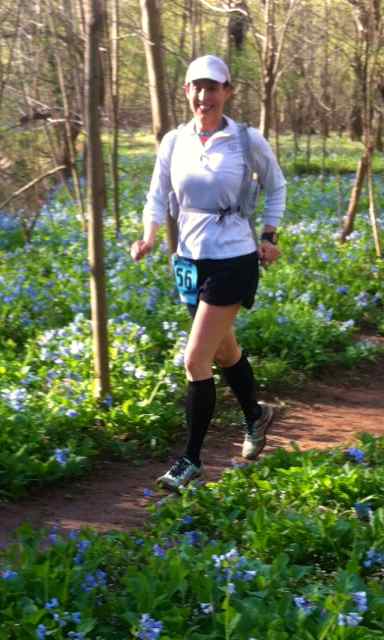 | Today's weather is somewhat warm, with temperatures rising from the upper 40's into the upper 60's during the day, rather uncomfortable especially when the sun hammers us and breezes pause. My fingers swell up, but not horribly so. Stephanie's do likewise. We take S! electrolyte capsules and Clif Shot energy gels at intervals, drink water from our hydration backpacks whenever we remember to, and nibble on salty treats from the aid stations. Fields of lovely bluebell flowers border most of the first 16 miles of trail, the upstream out-and-back part of the BRR course. We go slowly and hold our pace down to 14-15 min/mi. That proves to be a proper tactic today. We make all the cutoffs quite comfortably with 30-45 minutes to spare, and are able to take long walk breaks during the final stages when fatigue begins to set in. As I so often say, "It all turns out OK!" A red Mophie battery pack charges my iPhone during the run, since otherwise it would have run out of power before the finish. A new Garmin model 910XT, bought after Stephanie's experience with another Garmin extended-battery-life GPS, works well. Both GPS systems diverge by a few percent from each other and both suggest that the course wasn't as long as the official numbers. No matter! See Garmin and Runkeeper for detailed trackfiles and splits. (photo of ^z by Aaron Schwarzbard) | 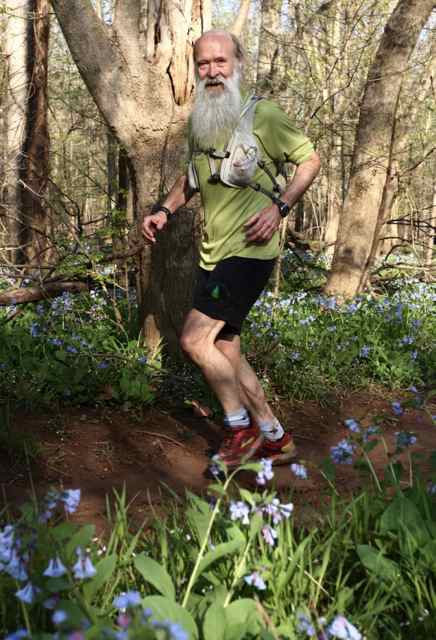 |
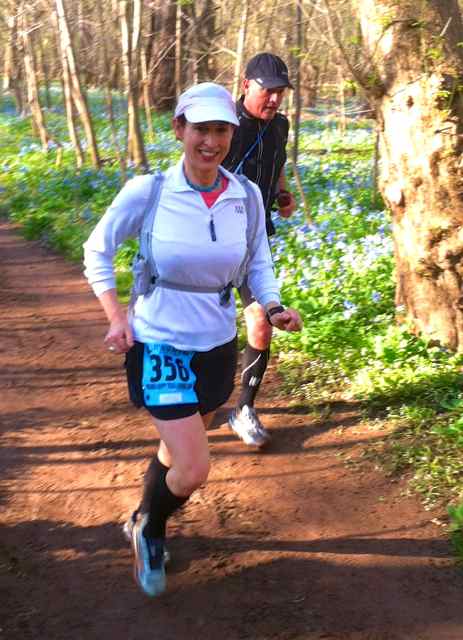 | "And that will up-regulate the beta oxidative cycle!" A tall fellow is cruising near Stephanie and me during the first part of BRR. We introduce ourselves and commence one of the most technical conversations perhaps to have occurred during an ultramarathon. The gentleman is D. Marshall Porterfield, Purdue University professor who's serving as a NASA project administrator now. Marshall is also an Ironman and a veteran of multiple 100 mile trail runs. Stephanie and Marshall discuss diet, diabetes, intermittent fasting, epidemiology and biomedical experimentation during miles 13-16 as we return from the northern turnaround to the Hemlock Overlock start/finish area. A few miles later Marshall pauses to point out a near-perfectly-camouflaged frog on the trail. It looks precisely like a lump of lichen, but with two big beady eyes that watch us. Marshall runs on, and finishes ahead of us in spite of serious knee issues. | 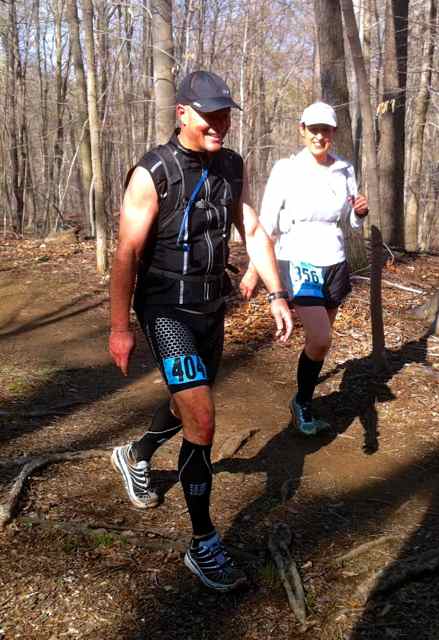 |
| Scary adrenaline-surge moment: at mile 17 during the descent from Hemlock Overlook back to the stream, Stephanie trips on a root or rock and takes a serious fall. It could have been a game-ending face plant. But fortunately, as Stephanie tells it, her (uh) generous (ah) endowment (um) cushions the impact and saves her from a broken nose. A volunteer ahead of us and a runner behind both hear the fall but don't witness it directly. Stephanie emerges with big scrapes on right arm and left leg, as well as a sudden headache and as a badly bruised nose. The rest of the race is, thankfully, less eventful. At mile ~25 Stephanie notices little yellow dots covering my face and scalp — seeds from some bush that I brushed against. Coconut-flavored ice pops at an aid station are welcome refreshment and remind us of an in-joke. In the DO LOOP segment of the course, on one of the old rusty car hulks, a giant inflatable "Hello Kitty" balloon bows to us, as Bruce Springsteen's "Born to Run" plays on a boom box. Deep in the woods Stephanie suddenly hears a big tree branch crash to the ground. Thereafter, every time a widow-maker crackles in the wind she jumps. At one point she is so certain that a limb is plummeting to kill us that she covers her head, cowers, and shouts, "Where is it, Mark? Where is it?" Fortunately, nothing seriously threatens, though around mile 40 I feel something bite me on the left shoulder. Frenzied swatting and pinching eventually stops the attack. When I peel back my shirt the creature turns out to be an iridescent emerald-green ant-like insect. Ouch! As we proceed downstream fast young Keith Knipling greets us as he heads northward on the return trip, a dozen or so miles ahead of us. A few weeks ago Stephanie and I followed his progress at the legendary Barkley Marathons. We step aside and salute him as he passes. About mile 43 Stephanie and I catch up with Andrew Harter, who is badly dehydrated. Apparently he's trying to do the run without a bottle, a dangerous gambit. Stephanie and I offer him water from our backpacks, and he drinks from mine like a camel, makes it to the Marina aid station, soaks up more fluids there, and successfully finishes just behind us. In the final segment of the race we meet Shelley Cable. She and Stephanie engage in a rather clinical discussion of breast-feeding, including a friendly competition as to who stayed the course longer for their nursing babies. The duel concludes with a mutual fist-bump celebration. Go Mamas! (photo of ^z by Aaron Schwarzbard) | 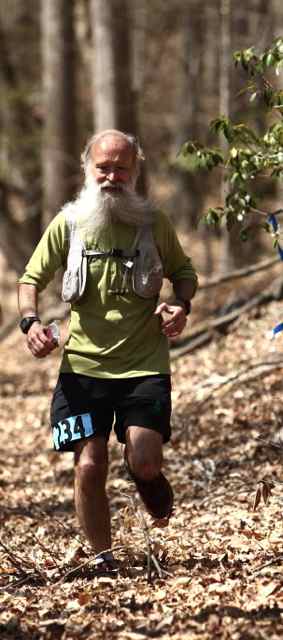 |
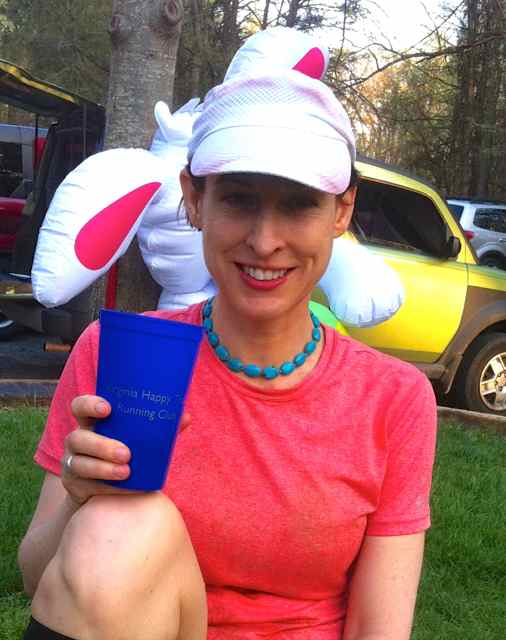 | Just before we turn to make the steep final climb to Hemlock Overlook Stephanie spots a lovely Great Blue Heron standing in Bull Run. As we approach the finish line we talk about "Accumulating Positives" and how fortunate we both are to be able to do such an awesome thing as run 50 miles in the woods together. Sweet! Kilt-clad comrade Mike Edwards is the organizer of Team Rocket, "the team dedicated to doing evil with Pokemon". We win the Slowest Team Award by a good margin, thanks in part to Mike's waiting several minutes for us just before the home stretch. The official results show: 277 Fonda Stephanie F 45 Kensington MD North 12:28:37
278 Zimmermann Mark M 60 Kensington MD North 12:28:38
279 Edwards K Mike M 50 Rockville MD North 12:28:38
Mike goes far beyond the call of duty: he picks me up at my home at 4:30am for the drive to the race, and gives both Stephanie and me a ride home afterwards. Bravo, Sir! |
(cf. Bull Run Run 2007, Bull Run Run 2008, 2009-04-18 - Bull Run Run, 2010-04-10 - Bull Run Run, 2011-04-09 - Bull Run Run, ...)
- Friday, May 10, 2013 at 07:02:55 (EDT)
At the library used-book sale last week a copy of The Four Agreements by Miguel Ruiz appeared. I snagged it for a friend who, I thought, might enjoy it, based on another friend's recommendation. Alas, it's rather too mystical, repetitive, and pedestrian in language to appeal to my perhaps overly-picky philosophical taste buds. On the other hand, the four "Agreements" are sharp (if non-orthogonal) guidelines for a happier and likely more-productive life:
- Be impeccable with your word
- Don't take anything personally
- Don't make assumptions
- Always do your best
They overlap with, but are interestingly different from, more abstract precepts that I've been thinking about lately (mindfulness + non-attachment + oneness and the like). Ruiz's main focus is on the psychological; what he suggests seems reasonable. But "ancient Toltec wisdom"? Gotta be skeptical ...
- Thursday, May 09, 2013 at 05:01:00 (EDT)
Keith Johnstone in Chapter 4 ("Spontaneity") of Impro for Storytellers tells how people make themselves nervous and unproductive by "trying" too hard:
At school a 'Buddhist' tranquility would have got me smashed on the head, but if I gnawed my pencil and crunched up as if in agony, my teachers would perceive me as 'trying' and would either write the answer for me or veer off and torment someone else. This strategy kept me safe, but it didn't teach me anything, and it carried the risk that 'thinking' might become a 'forced activity', never again to be experienced as effortless.
...
' "Trying harder" can't make you spontaneous; it's like trying to slam a revolving door!'
(cf. Unselfing (2009-01-14), ...)
- Wednesday, May 08, 2013 at 04:10:25 (EDT)

(... taken from a bridge over the Washington DC area Beltway, I-495, on 2013-04-12 ...)
- Tuesday, May 07, 2013 at 04:15:38 (EDT)
A used-book-sale tome snagged for a friend: NLP by Joseph O'Connor & Ian McDermott. NLP means "neuro-linguistic programming" and calls itself "the psychology of excellence". It proposes to bring ideas from neurophysiology, linguistics, and cognitive science to bear on mental issues. According to NLP there are four key principles or pillars:
- rapport - relationships of trust and responsiveness, with oneself and with others
- outcome - knowing what one wants, setting and understanding goals
- awareness - acuity of sensing what is actually happening
- choice - behavioral flexibility, picking what to do
Each of these has features to consciously appreciate and practice. To control and improve rapport, pay attention to body language, tone of voice, choice of words, responses to statements, etc. Outcomes need to be realistically achievable, motivating as goals, and desirable. Awareness is paying attention, mindfully, to one's internal states. Choice can be assisted by building "anchors", stimuli that serve as reminders. "The first practical step is to become aware of the anchors that put you in an unresourceful state. Once you know them, you can choose whether or not to respond. The second step is to design your own anchors." Thus, once can associate a mental image, a sound or word, and/or a gesture (like a mudra) with a positive state, and trigger it at will.
That's only the first half of the book. Convincing? Wikipedia's article on NLP is, at the moment, scathing in its evaluation of NLP as pseudoscience. Hmmmmm!
- Monday, May 06, 2013 at 04:11:50 (EDT)
Leanne Shapton's autobiography Swimming Studies talks boldly about emotional highs and lows. In the chapter ""Piña Colada" there's a striking introspective analysis of one heightened mental state with a male-female-introspective twist:
Nina and I sit under a beach umbrella, two piña coladas in. I've just finished describing to her how easily I develop crushes, using as an example the man in the waiting area at the airport who boarded the small plane after us and who, before takeoff, declined my offer of an organic macaroon, explaining that he did not eat sugar. I am extolling the virtues of such crushes, that women need muses too, need to get a little carried away by the physical, the way men always have been, that though you have no idea who these people are, do not act, and will never see them again, there are those thrilling minutes when you know your body with every cell and yet don't know yourself, when you imagine the people in your life don't matter and you would give everything up. Nina barely noticed the man, while I was gulping reality down with my bottled water, afraid to turn around, fearful that James, two seats away and three years into our relationship, could tell.
- Sunday, May 05, 2013 at 04:10:57 (EDT)
In the latest Phi Beta Kappa newsletter, Secretary of the society John Churchill writes movingly about the purpose of education. He concludes:
It is time to reassert plain facts. College is not only about training for jobs. It is about citizenship. It is about shaping oneself in a community into a fully-realized adult person. It is about learning to cope constructively with questions of meaning and value. In a democracy, we need to take as many of us as possible, as far as possible, down that path.
("From the Secretary", Spring 2013 issue of The Key Reporter; cf. EducationOfTheYouth (2001-12-01), PursuitOfExcellence (2002-02-22), LiberalArts (2003-03-13), SkillsOfDeliberation (2006-03-23), ...)
- Saturday, May 04, 2013 at 04:47:50 (EDT)
~18 miles @ ~12.9 min/mi
| "I'm doing something new at Bull Run," Stephanie Fonda promises. "I'm not doing anything new!" In other words, instead of experimenting during a tough 50 miler with untested gear, food, foot placement, shoe style, etc., this time for a change Stephanie promises to stick to the tried-and-true. Good idea — and the self-referential nature of the line echoes a mini-lecture I gave earlier today on Gödel's Theorem and its self-referential proof of mathematical incompleteness. Today is a final major trek before Bull Run Run, six days in the future. Stephanie made it off the Wait List and into the race only during the final hours last night before the deadline. And for both of us, BRR is really just a training run. I'm preparing for the C&O Canal 100 miler at the end of the month, and Stephanie is running the Pittsburgh Marathon early in May. Yes, it's rather audacious (or foolish?) to do a major ultra so close to a goal race, but hey, audacity apparently is a character trait (or fault) we share. I arrive ~7am via #5 bus to Chez Fonda in Kensington. It's cool, temps in upper 30's or low 40's, with a brisk south wind. Family cat Lava rises onto hind legs and rubs against my hand. Family dog Duck sniffs me as we prepare to go. After a pause to get GPS satellite locks we're on our way, along Strathmore a mile to the Bethesda Trolley Trail (BTT), pausing at the Volunteer Fire Station for photographs by the "LEARN NOT TO BURN" sign. Then onward it is, to downtown Bethesda where Stephanie reminds me to eat and drink. At mile ~5 we join the Capital Crescent trail (CCT). We take walk breaks from the start and try to hold our pace to ~13 min/mi. "It's still too fast for Bull Run," I note, "but I know you can't stand to go any slower!" Much trail talk ensues, including hypomanic chatter from me despite repeated promises to bite my tongue and stop havering. Stephanie promotes the virtues of toe strike; I concur with the suggestion that "running gently" with a light stride is helpful too. We discuss meditative-awareness mindfulness techniques. Stephanie recommends observing while not reacting, remaining nonjudgmental, and "Accumulating Positives" such as happy memories. I mention the "Notice and Return" and "Softening into Experience" mantras which I've found helpful during hard races and other stressful circumstances. Stephanie tells me about the Nova/PBS special "Decoding Dogs" and recommends it, as well as "Rat Attack". I comment on issues of lower-case-buddhism, the thesis of Stephen Batchelor's Buddhism Without Beliefs and much of Jon Kabat-Zinn's writings. Is it still the same religion if one subtracts karma, reincarnation, and other mysticism? Hard to say, but that's the topic of Owen Flanagan's Bodhisattva's Brain, a book that I'm just beginning to read. | 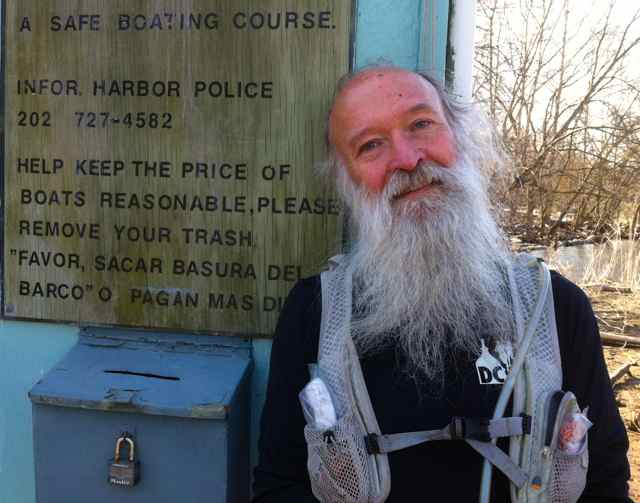 |
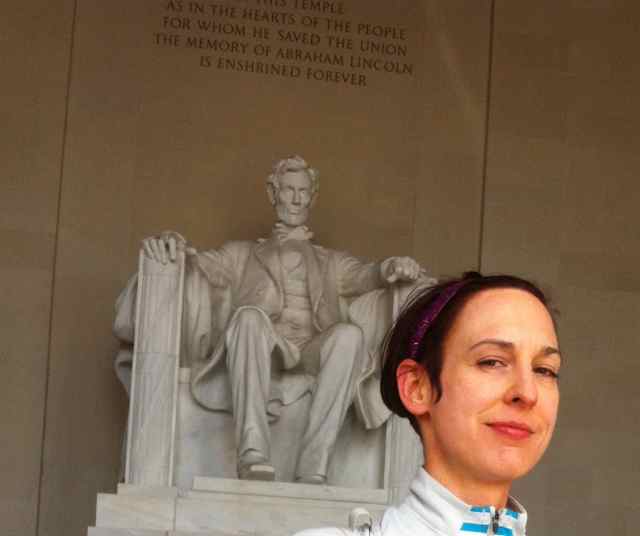 | Both Stephanie and I are still in awe of the Barkley Marathons finishers this year, Nick Hollon and Travis Wildeboer. We fantasize about doing a single Barkley 20 mile loop. I confess to a gentle obsession focusing on The Ring at Massanutten Mountain. We discuss Michael Wardian's be-tough-on-yourself training regime ("I usually don't eat or drink too much on runs as I like to train in the worst possible condition, so on race day, when I have water and PowerGel, it really works.") Lots of cute dogs are out on walks today, as are lots of cute fast runners (not to mention cyclists) who zip past as we walk every ~5 minutes or on small hills. At McDonalds in Bethesda, mile 7, we enjoy the facilities and pick up a Senior Coffee (price $0.85), as much for warmth as for caffeine. Stephanie recommends coconut oil for dry skin, and we discuss experiments with Metamucil (psyllium) to possibly reduce cholesterol. At Fletcher's Boathouse near our mile ~11 we go down to the river to take photos and dip fingers into the water. Airplanes flying into National Airport cruise low over the Potomac River, and Stephanie suggests crossing into Virginia and going to the Marina (Gravelly Point) to lie directly under the Final Approach flight path. I'm reminded of the scene in the movie "Wayne's World" (though I can't remember the movie title at that moment) where Wayne and Garth lie on the hood of their car in an analogous location. We play leapfrog with ladies walking and running on the CCT as we approach Georgetown. Now Cherry Blossom street closures and crowds slow our progress. We proceed to the Lincoln Memorial and at mile ~15 take photos of each other inside, then pause to touch the engraved marker on the step where Martin Luther King Jr. stood during his "I Have a Dream" speech. East then past the Washington Monument, we miss the chance to visit the Vietnam Veterans' Memorial and the National Science Foundation Einstein Statue — another time, I promise. "Yeah!" Stephanie says, in faux New York City accent, when her GPS rolls over to 16 miles. We then accelerate for a fast mile 17 along the north side of the national Mall. As we approach Union Station I suggest stopping our GPS's at mile 17.5, but Stephanie insists on a detour to reach 18.0 total. Au Bon Pain provides coffee, and after phone calls/texts to family we take the subway back to Grosvenor and walk toward Stephanie's place, so she can get ready to visit a sick friend in the hospital. Charlie, Stephanie's husband, sees me waiting at the bus stop as he heads out for an errand. He kindly offers me a ride, and I thank him but decline. Bottom line: I'm down 3 lbs. from dehydration, but feel great. "It turned out OK," as I always say — another fine run with a fine friend! |
Runkeeper and Garmin concur. Splits from the latter: 12:35 + 12:18 + 12:51 + 11:58 + 12:42 + 13:00 + 14:58 + 13:42 + 12:22 + 10:25 + 16:01 + 13:00 + 13:02 + 11:16 + 15:34 + 12:45 + 10:26 + 12:44.
- Thursday, May 02, 2013 at 04:08:27 (EDT)
Chapter 27 ("Use Your Will") of the lovely little book Just One Thing by Rick Hanson talks about how to bring commitment to the pursuit of "your highest purposes, which lift you and carry you along". The author, in a gentle and encouraging style, focuses attention on four adjectives:
- Ardent — ... wholehearted, enthusiastic, and eager ... heartfelt and passionate about your aims and activities ...
- Resolute — ... wholly committed and unwavering ... an experience of absolute determination ...
- Diligent — ... conscious and thorough ... "love, take delight in" the stepping stones toward your higher purposes ... translate big purposes into small, doable daily actions ...
- Mindful — ... know if you're being willful or lackadaisical ... aware of your inner world ... recognize if you've grown willful to a fault ... able to make skillful course corrections that keep you aligned with your highest purposes.
And bottom-line, Hanson concludes with a reminder to do all of this with a happy spirit. "Take pleasure in the strength in your will, and the fruits it brings you."
- Wednesday, May 01, 2013 at 04:14:40 (EDT)
In the 2013-04-29 issue of The New Yorker John McPhee writes about writing, and en passant touches upon a delightful topic: demonyms, words that describe residents of particular locations. McPhee loves them, and in the course of praising extraordinary copy editor Mary Norris observes:
... In 2003, we were closing the piece that retraced the journey made in 1839 by Henry David Thoreau and his brother, John, down the Concord River to the Merrimack and up the Merrimack through and beyond Manchester. In manuscript and in the initial galley proofs, there was a sentence (odd out of context) that said:
In bed at night for three or four months I'd been listening to Manchester laughing—a chorus of Manchesterians sitting on those steps convulsed by us on the way uphill with our canoe.
Mary Norris wrote on the proof, "Would you like 'Mancunians'?"
It was as if she had handed me a rare gold coin. Five years later, when I happened to be writing about lacrosse in Manchester, England, I worked in the word "Mancunian" three times in one short paragraph. It was the second-best demonym I'd ever heard, almost matching Vallisoletano (a citizen of Valladolid). The planet, of course, is covered with demonyms, and after scouring the world in conversations on this topic with Mary Norris I began a severely selective, highly subjective A-list, extending Mancunian and Vallisoletano through thirty-five others at this writing, including Wulfrunian (Wolverhampton), Novocastrian (Newcastle), Trifuluvian (Trois-Rivières), Leodensian (Leeds), Minneapolitan (Minneapolis), Hartlepudlian (Hartlepool), Liverpudlian (you knew it), Haligonian (Halifax), Varsovian (Warsaw), Providentian (Providence), and Tridentine (Trent).
Mary Norris herself contributes to New Yorker blogs on language and editing issues ([1]). And apparently the word "demonym" is of recent coinage, attributed to Paul Dickson — who turns out to be a local writer whom I've bumped into on occasion in the Wheaton Library basement used-book sale room. Small world!
(cf. "The Writing LIfe — Draft No. 4: Replacing the words in boxes." by John McPhee)
- Tuesday, April 30, 2013 at 05:56:09 (EDT)
From Jakusho Kwong's thoughtful book on meditation No Beginning, No End, a lovely-encouraging image in Chapter 3 ("Half Moon Makes Full Halo"):
... I used to think that because only one half or one quarter of the moon was showing, there would be no full halo. But it turns out that even a twenty-five or fifty percent moon makes a one hundred percent halo. Whether it is full or not, the moon reflects that much light.
We should know that it is the same with us. When we cultivate our understanding and become aware of what we are doing, and actually see what is happening within ourselves and around us, we have that same kind of full halo. We don't have to wait until we can sit in full lotus, or until we have been sitting for ten or twenty years, as if only then something will happen. Some of us sit cross-legged, some half lotus, some full lotus, and some Burmese style or in a chair. These are only different views of the same moon. There are people who think that one form is better than the other, but it's not true. We are truly like the moon: Any amount of light makes a full halo.
(cf. Afraid of Chairs, Being with Your Breath, Dimensionless and Therefore Infinite, Without Effort, Analysis, or Expectation, Yoga and Mudra, ...)
- Monday, April 29, 2013 at 06:45:15 (EDT)
Recent Chinese fortune cookies here have been relentlessly positive:
- You are never selfish with your advice or your help.
- Your present plans are going to succeed.
- The one you love is closer than you think.
- You are broad minded and socially active.
- You are a bundle of energy, always on the go.
- You are talented in many ways.
- You always bring others happiness.
and the latest:
- You look happy and proud.
Sweet!
- Sunday, April 28, 2013 at 16:07:27 (EDT)
The Bull Run Run 50 mile ultramarathon includes a friendly team competition, with awards for fastest, oldest, etc. Every member of a four-person team must finish the race in order to be eligible to win a prize. The competition for slowest total team time, the only category in which I might have a chance, isn't exactly "heated" — it's more "luke-warm". This year another team, which shall remain nameless here, thought it had won in that biggest-loser category. But after BRR was over I appealed to the Director, who checked the records. He confirmed that my crew — "Team Rocket", aka the team devoted to doing Evil with Pokemon — in fact was slower. That gave us the win as losers and caused our rival team to lose that honor. But wait a minute: doesn't that make them a greater loser, since they failed to win as losers? But if they won, then they lost, and therefore ...
- Saturday, April 27, 2013 at 03:07:22 (EDT)
An improv routine that slumps to the floor and spreads into a puddle: alas, that's Truth in Comedy, a thin book that styles itself as "The manual of improvisation". After reading Keith Johnstone's Impro and Impro for Storytellers, perhaps the plodding and ill-structured form of Truth in Comedy is more distracting. Who edited it? And the print is too large, the layout of the book too amateurish, the binding of my paperback copy is already splitting. Meriwether Publishing Ltd. writes the copyright date by writing "1994" and "2001" in Roman numerals. Why, if not to slightly disguise the year? And the overall tone is a distracting mix of name-dropping and mutual-admiration-society ritual bows. Authors Charna Halpern and Kim "Howard" Johnson constantly salute their coauthor, the late Del Close, and too many salutes get in the way of progress.
Yet there are faint glimmers amidst the clinkers. In Chapter Eight ("One Mind, Many Bodies"), for instance:
The ImprovOlympic workshops constantly prove that a group can achieve powers greater than the individual human mind. Scenes created have turned out to be prophetic, and ESP has actually occurred on stage. Players are able to speak simultaneously, at a normal rate of speed, saying the exact same thing, word for word. Some teams became oracles on stage, answering the great questions of the universe, one word at a time, leaving audiences chilled and astonished.
Audiences have witnessed the group mind linking up to a universal intelligence, enabling them to perform fantastic, sometimes unbelievable feats. It only happens when the group members are finely attuned to each other, but it almost seems like they are tapping into the same universal consciousness that enables individuals with special abilities. Somehow, we are able to connect to it — and all improvisers know the value of connections!
That's a fascinating, but sadly pedestrian, description of a phenomenon that needs proper documentation, illustration, and analysis. Please, somebody, do that — and then write it up with wit and sparkle!
- Friday, April 26, 2013 at 04:04:56 (EDT)
At an industry association meeting I attended last week the lunchtime speaker inadvertently demonstrated what not to do in order to give an engaging presentation:
- Begin with a lame self-deprecating joke ("They say I'm pretty fly for an old guy, but ...")
- Read and discuss a dictionary definition of a word in the title of the talk
- Plod through irrelevant facts and figures — statistics that would have required an almanac or encyclopedia to look up in past decades, but which now are two clicks away
- Offer a numbered list of platitudes as recommendations — none of which are actionable, measurable, or connected to the earlier parts of the talk
- Finish with more attempted humor ("I may sound like a MOTO, a Master Of The Obvious, but ...")
- Thursday, April 25, 2013 at 05:15:12 (EDT)
~20.5 miles @ ~10.5 min/mi
Sweat washes sunscreen into my eyes. The trek down the Metropolitan Branch Trail begins from home at 9:30am. I'm taking the first day off work in a long time; at last I'm approaching use-or-lose territory in the office leave ledger. Temperatures are properly spring-like after a chilly spell, and soon the sleeves are rolled up. No water fountains are working along the route, so I sip cautiously from the single bottle I carry and nibble a Clif Mojo Bar.
Construction blocks a street at Catholic University and forces a detour around a couple of blocks. The mural on the wall outside The Dance Place is repainted: sadly, the comely high-kicking lady that I loved is replaced by a less-eye-catching motley crew. I pause to photograph the new artwork, then accelerate to sprint in honor of Stephanie Fonda's 8:17 at mile 10 near the NoMa Metro station. The Garmin wrist GPS clocks me at 8:11, but Runkeeper is offset and says 8:01.
At Union Station I wander indoors for a few minutes and finally find a working water fountain to refill my bottle. DS Merle texts me and DS Robin phones to suggest a lunch at Jerry's when I return. The shortest route home is up Massachusetts Avenue. In the center of Mount Vernon Square the Washington Public Library donated by Andrew Carnegie is worth pausing to photograph. Behind the benches outside the southern entrance are the words "A VIVERSITY FOR THE PEOPLE". High above the door it says "THIS BVILDING A GIFT OF ANDREW CARNEGIE", "WASHINGTON PVBLIC LIBRARY", and "DEDICATED TO THE DIFFVSION OF KNOWLEDGE". Beneath them the inscription reads "SCIENCE - POETRY - HISTORY". A beautiful structure!
Pauses at traffic lights are minor, but now I'm starting to feel seriously dehydrated. A young woman runs past as we climb Meridian Hill and vanishes into the distance. Walk breaks begin at five minute intervals, then stretch to include anything that looks like an ascent. Metrobuses tempt me to catch a ride. I ponder the possibility of entering a church or knocking on a front door to beg for water. But at last the tall apartment towers in Silver Spring come into view, and I decide to keep on hiking home. My weight is down 4 lbs. Note to self: carry more water!
Runkeeper splits are 9:35 + 10:28 + 8:48 + 9:12 + 9:27 + 10:38 + 9:11 + 9:42 + 10:41 (taking photos at The Dance Place) + 8:01 (blitzing!) + 12:00 (seeking water in Union Station) + 9:41 + 11:49 (taking photos of the Carnegie Library) + 9:50 + 9:57 + 10:45 + 9:56 + 10:49 + 12:05 (increasingly dehydrated) + 12:49 + final fraction at 11:47 min/mi pace. The Garmin data is similar.
((cf. 2012-06-10 - Metropolitan Branch Trail to Clair, http://zhurnaly.com/zhurnalywiki_static/2012-10-21_-_Metropolitan_Branch_Kicking_with_Stephanie, ...)
- Wednesday, April 24, 2013 at 04:10:36 (EDT)
In the chapter "Practice" of Leanne Shapton's autobiographical Swimming Studies, a striking observation about what happens when a body is driven hard, so hard that it's on the verge of failure:
While watching the French Open one morning on television, I leave my chair and walk toward the kitchen. John McEnroe is commentating, and as I put the kettle on I hear him mention that Rafael Nadal is playing through a sprained ankle. I remember the blunt fact that when I was training, I was in constant pain. Not just the sharp pain in my knees, which was taken seriously, but a dull, steady pain in my arms, back, and shoulders. Pain when I sat down, pain when I got up, pain when I leaned back in a chair, pain when I reached for the salt or sharpened a pencil. Thinking of stoic Nadal, I remember how I ignored, then eventually forgot about, pain when I raced, and even to some degree during practice. It was as though pain on land was there to remind me to get back in the water, where, after a certain threshold, the pain went away. For an athlete pain is not a deterrent, because the only place the pain will be eclipsed is in practice or in competition.
(cf. Cave of Pain, Dark Place, Don't Wish It Were Easier, ...)
- Tuesday, April 23, 2013 at 04:07:30 (EDT)
~3.2 miles @ ~11.4 min/mi
At dawn on the last near-freezing morning of spring Ed Brown begins in the lead. Kerry Buckley and Kristin Heckman soon move ahead, however, laughing and chatting. They kindly wait for Ed and me to catch up at each corner. I argue the merits of speedwork. Ed tells of his personal trainer and gymnasium exercise regime. Runkeeper and Garmin GPS concur on distance and pace.
- Monday, April 22, 2013 at 04:05:45 (EDT)
In The Philosopher's Magazine (1st Quarter 2013 issue) Julian Baggini leads off "The best books of 2012". He recommends Owen Flanagan's The Bodhisattva's Brain: Buddhism Naturalized in such brilliant prose that I simply had no choice but to buy a copy at once. Baggini's complete review simply reads:
Most philosophers are bright and well read. A handful has genuine insight. Very few are able to look at an ancient religious tradition and be both scathing about its supernatural excesses and sympathetic to its real wisdom. Hardly any can write clearly, rigorously and with vim and humour. A minority say things of importance to people outside the profession. Take these groups and arrange them in a Venn Diagram. Owen Flanagan sits in the very lonely space where they all overlap.
Such piquant praise! And as Flanagan himself writes in his book's Introduction:
Imagine Buddhism without rebirth and without a karmic system that guarantees justice ultimately will be served, without nirvana, without bodhisattvas flying on lotus leaves, without Buddha worlds, without nonphysical states of mind, without any deities, without heaven and hell realms, without oracles, and without lamas who are reincarnations of lamas. What would be left? My answer is that what would remain would be an interesting and defensible philosophical theory with a metaphysics, a theory about what there is and how it is, an epistemology, a theory about how we come to know what we can know, and an ethics, a theory about virtue and vice and how best to live. This philosophical theory is worthy of attention by analytical philosophers and scientific naturalists because it is deep. ...
That's a fascinating vision. It echoes Stephen Batchelor (Buddhism Without Beliefs), Jon Kabat-Zinn, and others who try to cleave away silly mysticism and inspect the facets of what gem remains. Can the rest of Bodhisattva's Brain continue as powerfully? Will Flangan succeed in his offer that, "... Buddhism naturalized, if there is or can be such a thing, delivers what Buddhism, possibly uniquely among the world's live spiritual traditions, promises to offer: no false promises, no positive illusions, no delusions." What's left for those who, again in his words, "Just say no to the supernatural."? We shall see ...
(cf. Core Buddhism (2011-10-17), ...)
- Saturday, April 20, 2013 at 16:46:46 (EDT)
~2 miles @ ~9 min/mi
"Is that Jesus?" asks a little kid in soccer class as I zip past on my first lap around the lovely rubber-surfaced Bowie High School track. I wave a blessing at him. Before the sun sets there's time for half a dozen 400 meter intervals: 1:43 + 1:39 + 1:39 + 1:37 + 1:39 + 1:36, that last one close to the Puke Point. Taco Bell down the street soon settles my tummy. DW's rehearsal is in the nearby auditorium at the Bowie Center for the Performing Arts. Runkeeper and Garmin show the oval.
- Friday, April 19, 2013 at 04:06:31 (EDT)
Keith Johnstone in Impro for Storytellers (Chapter 4, "Spontaneity") observes:
... I might tell them about Kimon Nicolaides, who taught life-drawing, and who said that 'The sooner you make your first five thousand mistakes the sooner you will be able to correct them.' Then I might add, 'Learn to ride a bike on grass so you don't lose any skin, and stand facing a bed when you learn to juggle so that you don't have to keep chasing the balls, and always try to improvise with people who understand that it's okay to screw-up. And remember that if you succeed brilliantly, you'll depress the rest of us, and then we'll never get any volunteers.'
(cf. Make Mistakes, ...)
- Thursday, April 18, 2013 at 04:06:37 (EDT)
~5 miles @ ~11.6 min/mi
Cara Marie Manlandro is back for Easter weekend from finishing-up-the-dissertation work in Milwaukee, so at 6:44am we start running at her home. CM hasn't been able to run much on the icy sidewalks — she reports seeing "-10° F" on her car dashboard thermometer one frigid morning — but she's in pretty good shape thanks to her private gym. The facility actually is for general use, but thus far nobody else has ever used it in her experience, at any time of day. Nor do comrades at the University of Wisconsin Medical School climb the stairs or do much other visible activity. Milwaukee is, however, noteworthy for beer, and CM remarks on the freeway that runs through a Miller brewery. She is proud to have maintained her low weight, in spite of all this. We trot along, take walk breaks, and reminisce about races and training runs together. A crimson sunrise gleams through clouds. At the end of Indianola Dr a deer leaps fences and dances through back yards. Garmin GPS and Runkeeper trackfiles concur.
- Wednesday, April 17, 2013 at 04:09:42 (EDT)
Gibbous moon glows
Through a hole in the clouds
Shaped like a map of Britain |
(as seen during the first mile of 2013-03-30 - CCT and C-and-O Canal Towpath)
- Tuesday, April 16, 2013 at 04:11:08 (EDT)
~26 miles @ ~12.5 min/mi
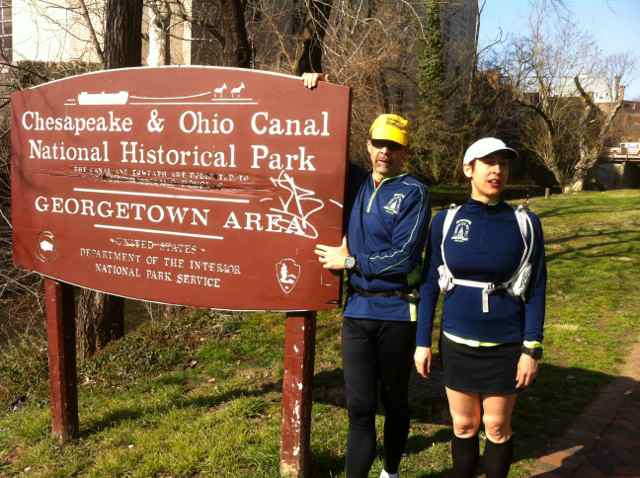 | Barry Smith and Stephanie Fonda wear coincidentally similar Annapolis Strider outfits this chilly morning when I meet them. We're north of Massachusetts Av on the Capital Crescent Trail, and I'm coming back toward Bethesda with Gayatri Datta and Sam (Sandra) Yerkes about 7:45am. I've jogged here from home starting before dawn. By this point my fingers are already too weak to tear open a blueberry Luna Bar package. Stephanie attacks the wrapper for me. We cruise down the CCT together, passed by flocks of MCRRC training group runners. Most of the water fountains are turned off. At Fletcher's Boathouse we wait in line to buy liquids, but after five minutes of no progress we give up and proceed down to the Thompson Boat Center in Georgetown. There, a garden hose answers our needs. Stephanie points out a tree full of cormorants over the Potomac River. She tells of time spent in the western US desert, and the song "Horse With No Name" plays in my head. Barry identifies the band as America, and reports having seen them perform live. Stephanie is interested in possible anti-cholesterol effects of psyllium, the main ingredient of the laxative Metamucil, and suggests that Barry and I be her experimental subjects in a study of it. We hesitate to volunteer, especially before a long run. As we turn the corner at the Kennedy Center to proceed up Rock Creek Parkway to join the C&O Canal at its beginning, who should greet us but Hilary Swab and her fiancé? "Makes a day great," I tell Barry and Stephanie, "when somebody who knows you spots you so far from home!" We pass a field of daffodils, and when Barry says he's tired and wants to rest, I suggest, "Why don't you lie down and wave your arms to make daffodil angels?!" (see Narcissus Silhouette) We trot along Georgetown sidewalks, crossing streets cautiously. A runner in a black shirt looks tired as we overtake him. I offer help, and he declines but thanks me. A block later as we're all climbing to the bridge to cross to the other side of the canal he passes us. I see that it's a Boston Athletic Association top he has on, and whisper to him that I've just BQ'd. He did it in 2011, when he turned 50. Stephanie tells an anecdote re testosterone and its effects on brain chemistry in addition to muscle-building. I mention an over-the-top Andrew Sullivan essay in the New York Times that stuck in my mind from 13 years ago. Barry and Stephanie discuss their plans to run the Bighorn 50k in a few months, and the possibility of driving there via the Lewis & Clark expedition route — a long road trip! |
At Fletcher's Boathouse I find a corroded cent on the ground. We take walk breaks as needed. When the GPS says a little over 17.5 miles we could stop, but Barry insists on a few extra blocks to make it 18. "It looks better that way!" We comply. Barry kindly gives me a ride home. We listen to "Wait, Wait, Don't Tell Me!", a comic radio program on NPR, which he and Stephanie had mentioned during our trek. Runkeeper and Garmin logfiles agree to within ~0.5%.
- Monday, April 15, 2013 at 04:42:41 (EDT)
The Philosophers' Magazine (1st Quarter 2013 issue) carries a lovely obituary of Australian thinker John Jamieson Carswell Smart written by his colleague John Bigelow. Jack Smart became persuaded, in the early 1950's, that "... all our conscious thoughts and feelings are electrical and chemical proesses occurring within our brains." Bigelow explains how glorious a physical concept of mind could be:
Many felt this materialist theory was demeaning to the things they deeply valued, including things like art, God, freedom, immortality, and so forth. But Jack so loved the beauty of the mathematical laws of physics and chemistry that he truly felt his materialist theory of the mind to be not bad news about the mind but good news about the material world. The material world is so wonderful that, in the right circumstances, it can be all of those things that we value so deeply.
From this theory it follows that when the brain is no longer functioning a person will have no more thoughts and feelings. But Jack took comfort from a second philosophical theory, derived from his interpretation of Einstein's theories of relativity. Smart argued that we live in a world of "space-time" that has four dimensions, and we perceive three of these as dimensions of space and one of them as time. Which of the infinitely many possible directions in space-time you perceive as "time" depends on your "frame of reference". So really, Smart concluded, time is much more like space than people realise. In fact, Smart believed that every second is literally just over 299 million metres long. If you could rotate Smart's 92-year life history through ninety degrees within the space-time manifold, he would reach far enough to touch the stars.
Consequently Smart held that things that are past or future exist in the same sense that we exist right now. It may be sad for us that we are distant from things that are past, but we can take comfort from the thought that they exist in the very same sense that we do, just at a space-time location distant from us.
Sweet and comforting thoughts indeed. I will refrain from quibbling about the fact that the "time" dimension has the opposite sign from the "space" dimensions in the relativistic metric, so one can't simply "rotate ... ninety degrees" in any conventional sense. No worries, mate! And as another obituary to Smart observed, he "... never wavered in his sense of awe and wonder at the incredible beauty of the cosmos that science has discovered our world to be, governed as it is by astoundingly beautiful mathematical laws of nature. On top of that, he was a top bloke." Perhaps that's the perfect epitaph:
R.I.P.
Jack Smart
1920-2012
Top Bloke |
- Saturday, April 13, 2013 at 03:09:20 (EDT)
~6.7 miles @ ~8.8 min/mi
Feel tired after work when I arrive home. Nap, or run? After a mile I wake up a bit and begin to push the pace, for splits by Runkeeper of 9:08 + 8:25 + 9:02 + 7:58 + 8:50 + 8:54 + a final partial mile at 8:48 min/mi pace. Swing by Jennings Ct where there's a house DW has her eye on, only half a mile or so from the Wheaton Metro station. Elevation graph shows a peak at the corner of University and Veirs Mill, with the Mormon Temple hill on Stoneybrook relatively minor by comparison. Steep climb home via Forsythe Av is rough. Step aside for a #4 RideOn bus to pass by, run on the shoulder for other traffic. Garmin is in close agreement with the iPhone GPS.
- Friday, April 12, 2013 at 04:08:57 (EDT)
Crimson beams glint
From steel guard rails
As we run into the sunrise |
- Thursday, April 11, 2013 at 04:59:26 (EDT)
~10.7 miles @ ~12.7 min/mi
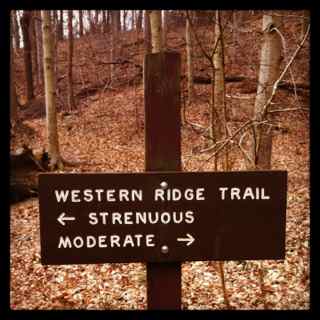 | DS Merle has substitute organ duty at Knollwood chapel this Sunday morning, so it's time to trek. Starting 9:30am on at the visitor's space outside the military retirement residence, down the driveway into Rock Creek Park, down the bikepath to the Western Ridge Trail, and downstream I flow. "Alive" by Krewella is on satellite radio as I drove this morning, and it's on heavy rotation in my head. A brilliant scarlet cardinal blitzes across my path. Dog walkers and trail runners exchange greetings. Which way to turn at the fork? "Strenuous" as always. I cautiously navigate the cliffs above the waters, then zig across the bridge and upstream along Beach Dr to find the Valley Trail. The stone bridge arching over Rock Creek is highly photogenic, but upon further examination rocks along the side appear to be a decorative façade. Runkeeper and the new Garmin 910XT concur to within 1%. |  |
- Wednesday, April 10, 2013 at 04:03:17 (EDT)
Guess my weight? The number has evolved over the decades, from a vague memory of scrawny mid-130-pound college years to scattered data points recorded in the ZhurnalyWiki Running Logbook, including:
For the past few years digital scale readings have fluctuated in the mid-140's, random-walking up and down as hydration and electrolyte vary. That's a bit over 10 stone, to use an archaic Imperial unit that somehow appeals. Should I try to skinny down farther? Would that continue to enhance speed, according to the rule-of-thumb that every pound lost grants a ~2 second/mile boon, a whole minute faster marathon? Or would my ~173cm (about √3 meter, ~5'8") frame fail from lack of meat? At my height a Body Mass Index of 20 corresponds to ~132 lbs; a 25 BMI is ~165 lbs. But does excessive scrawniness cost resilience? Does it increase the risk of injury, or of turning minor illness into major? When is less no longer more?
- Tuesday, April 09, 2013 at 04:21:16 (EDT)
~18.6 miles @ ~11.8 min/mi
"Good morning, Mr. Zimmermann!" Adeline Ntam greets me at dawn on the Capital Crescent Trail, just after I've paused to inspect the giant hole in the ground at Connecticut Av where a broken water main spilled 60,000,000 gallons down the Coquelin stream tributary of Rock Creek. I'm on my way to Bethesda to meet friends. Supposedly we'll all be at the Barnes & Noble bookstore at 7:30am. Ten minutes early nobody else is visible there, so I continue on to finish mile #4 and then hook back to text the missing parties. Sara Crum is there early too, and then Gayatri Datta arrives. Rather than wait, Gayatri heads down the CCT with Michele Price and her crew while Sara fumes and waits with me. Soon Jennifer Wieland is there, then Ken Swab, and then Rebecca Rosenberg followed by Emaad Burki. Perhaps we need a fallback plan to avoid unnecessary delays? I suggest to Sara an out-and-back eastward next time.
Southward on the CCT we go, with traditional bawdy banter between Emaad and Sara and sporadic footnotes from the rest. At the water fountain just past the Dalecarlia tunnel we find Gayatri and Co. I fall in with them for a few miles and talk with Gayatri about electrolytes and her experience during and after last week's B&A Marathon. Rebecca's injuries from her fall during that race are healing nicely.
After the group's 10 mile out-and-back (my mile 14+) everybody else is heading for home, but Sara Crum wants some extra distance and I need to get back to my starting point, so I volunteer to trot along with her. Rebecca kindly volunteers to drive me if I prefer, but I turn her down and explain that I need the extra hoof time to prepare for the Bull Run 50 and the C&O Canal 100 next month.
Runkeeper estimates 19.16 miles but the new Garmin 910XT says 18.63 and the old Garmin 205 is stingier yet at 17.99 — all probably divergent because of GPS lossage at multiple tunnels along the way. Rough mile splits based on the new wrist GPS: 10:34 + 9:21 + 9:52 + 10:25 + 25:27 (including ~15 minute break to wait for latecomers to arrive) + 10:07 + 10:23 + 10:15 + 10:43 + 12:20 + 10:29 + 10:57 + 10:33 + 10:45 + 18:04 (another break in downtown Bethesda to regroup) + 10:09 + 11:20 + 10:20 and a final fraction at ~10 min/mi pace.
- Monday, April 08, 2013 at 04:06:43 (EDT)
Chapter 26 ("Have Insight") of Rick Hanson's book Just One Thing returns to the theme of introspection and self-awareness. Hanson suggests a metaphor:
The mind is like a great mansion, with cozy dens, dusty closets, and dank cellars. Insight explores it, opening closed doors and making sense of what it finds: sometimes a treasure chest, sometimes smelly old shoes—though truly, it's usually treasure, including your natural goodness, sincere efforts, and lovingkindness.
But at times the mansion can also be scary. Hanson quotes the Alcoholics Anonymous advice: "The mind is a dangerous neighborhood; don't go in alone."
(cf. RichardWilbur (2005-06-30), ...)
- Sunday, April 07, 2013 at 05:12:02 (EDT)
~2.2 miles @ ~7.6 min/mi
Spring Break at the University of Maryland, and the gates to the track are locked. Marathon Deli closes at 8pm, so when DS Robin and I drop DD Gray off at orchestra rehearsal time is tight. Plan B it is: Paint Branch Trail on the eastern edge of campus. Yellow construction-barrier tape blocks the upstream direction before milepost 1.5, so down we head toward Lake Artemesia. I pound out a couple of fast miles and on the way back meet Robin sooner than expected. Runkeeper records splits of 7:27 + 7:42 and a final fragment at 8:17 min/mi pace.
- Saturday, April 06, 2013 at 09:21:04 (EDT)
When falling asleep,
In that brief gap between awareness
That one's consciousness is fading
And total loss of self —
What strange thoughts flow unrecorded,
Slithering away
As the mechanisms of memory
Shut down? |
- Friday, April 05, 2013 at 17:38:13 (EDT)
26.2 miles @ ~8.9 min/mi
BQ!
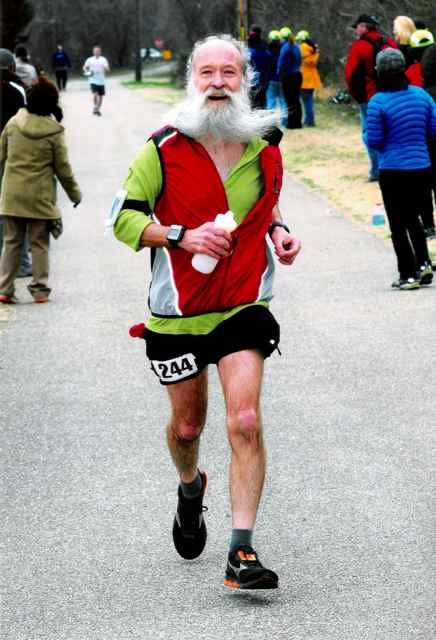
(happy ^z approaches the finish line — photo courtesy Annapolis Striders — click for high-res image) | The B&A Marathon 2013 produces a new personal best — 3:54:29 — a Boston Marathon Qualifying time by 31 seconds, and good enough for a second-place finish among the men in their 60's (a 69-year-old beats me by 11.5 minutes). Overall I'm 71st place of 181 finishers, behind 9 women and 61 men. "Gun time" is 3:55:30. The Garmin and Runkeeper GPS trackfiles agree within ~1% of the certified course markers, and confirm that the first half goes by in close to 2 hours flat. The second half-marathon is thus a monster negative split and unofficial PB at ~1:54:30. The total time is more than 3 minutes faster than at last year's event, which followed the same course but with a different start-finish along the out-and-back rail-to-trail paved path in the Pasadena-Severna Park-Arnold area of Maryland. See 2012-03-04 - B and A Marathon for data on that race and 17 previous road marathons. Weather conditions are near-optimal, cool and cloudy most of the morning with only a few drops of rain. My Chinese fortune cookie the night before the race has two slips of paper inside, and both say: "You will be fortunate in everything." The last Tarot card I draw, a few days earlier, is "Slowing Down" from the Osho deck. Hope that's not a portent! Like last year, I wear my lucky New Balance shorts, soft and with pockets, and my lucky shoes, an old Mizuno wave "Ronin" model. Also like last year I suck down an energy gel on the hour and half-hour, and take a Succeed! electrolyte capsule on the 15- and 45-minute marks. A hand-held bottle gets speedily refilled with Gatorade by cheerful volunteers at the aid stations, saving time and letting me sip comfortably along the way. I drink more than a quart. At sunrise I pick up Rebecca Rosenberg at her home and drive to Severna Park where the race begins. We hear Bob Dylan sing "Shelter from the Storm" on the satellite radio "Coffeehouse" acoustic music station just as the highway, MD-100, takes us underneath the B&A Rail Trail — the path that we'll be running on in an hour. As race time nears we're busy gearing up at my car a quarter mile away. We head for the starting line and commence a warm-up jog when we hear the race begin, thinking we still have plenty of time to join the crowd that has yet to cross the line. Then suddenly I realize that the crowd is made up of Half Marathon people, whose start is 5 minutes later than the Marathon. Oops! Rebecca and I stop lollygagging and dash to the front, ask permission of the race officials, and cross the mat already DFL. I hit the "Start" button on my Garmin GPS about a minute after the "Go" signal, within a second of the final chip time. It takes me another ~30 seconds to get the Runkeeper app going on the iPhone strapped to my shoulder. We dash for the first half mile and soon start passing people. When Rebecca finds some friends she falls in with them. I trot on ahead. |
About mile 2 I catch up with Joe and Greg, a wonderful pair who pull me along for the next ten miles. "Joe" is Joseph Zern of central Pennsylvania, a beer distributor who's doing his 98th marathon today and aims to reach #100 before his 60th birthday next month. Greg Bayvel is from northern New Jersey, a young stockbroker-turned-investment-advisor. Joe tells of his fast youth, sub-3 hour marathons, races in Tokyo and other exotic locales. Greg is 31 — "Is that Earth Years?" I ask, not believing my ears. He scarcely trains at all, just ties his shoes and goes out to run marathons when the spirit moves him.
Both Joe and Greg are aiming for about 4 hours today, so their pace is near-perfect for me. Joe recounts tragi-funny stories of cramping up in the final miles of the Marine Corps Marathon and other big races. He strongly recommends the strategy of negative-splitting, going faster in the second half. Greg reports seeing celebrities walking their dogs in New York City's Central Park. Joe tells of spotting Reverend Jesse Jackson walking the B&A Trail near where we are today. Both continue their cheerful banter as I cruise a few steps behind them for ~90 minutes. When they pause at an aid station near mile 12 I trot ahead. (Joe finishes in ~4:08, and Greg is ~4:18.)
The race is generally uneventful. Little kids call me "Santa", larger one say "Gandalf". Weather is brisk for the first few hours, but as I warm up first the cap gets doffed. Then the vest and shirt are unzipped, and finally off come the gloves. The B&A Trail is nearly flat, but I persuade myself that it looks downhill both ways. That helps me keep the pace up. During a few of the loop-backs I get to wave at Rebecca, plus Gayatri Datta and Sandra "Sam" Yerkes who are running with her. After the race I learn that early on Rebecca slipped and fell, scraping hand and arm and shin rather badly. But she perseveres.
When I reach mile 20 with only minor left foot metartasalgia I see that sub-4 looks likely and sub-3:55 — a BQ ‐ might be feasible. That would be significantly faster than my pre-race forecast to dear friend Kate Abbott. In a chat online she predicted "4:02 (sorry!)" and I countered with a 2-sigma range of 3:55:01 (one second too slow) to 4:15.
Although mental arithmetic is shaky I monitor the overall GPS average pace display and push to keep it below 9 min/mi, allowing a margin for GPS error. My calves are on the verge of cramping, so during the final miles I drink dry the bottle of Gatorade I'm carrying, then accelerate a bit. At mile 25 I walk up part of a slope to a bridge — the only walk break all day, aside from aid stations. Then it's Fly Or Die time: pour on the coal for the blitz to the finish line. Today it works.
Jeanne Larrison is a race volunteer and takes photos of me at the tent where cold pizza and bananas are distributed. Five minutes after I stop running my calves begin to cramp, rather comically. I lie in the shade under a cedar tree near where the official photographer lurks and watch for my friends to finish. Eventually the old calves relax and I can walk some more. Gayatri comes in ~4:41 and Sam and Rebecca cross the line about eight minutes later. What a great day!
Pace in min/mi from Runkeeper and the Garmin wrist GPS:
| mile | Runkpr | Garmin | | mile | Runkpr | Garmin | | mile | Runkpr | Garmin |
|---|
| 1 | 8:50 | 8:51 | | 10 | 9:22 | 9:18 | | 19 | 8:46 | 8:59 |
| 2 | 8:51 | 8:51 | | 11 | 9:12 | 9:19 | | 20 | 8:19 | 8:11 |
| 3 | 9:10 | 9:19 | | 12 | 9:43 | 9:35 | | 21 | 8:37 | 8:44 |
| 4 | 8:58 | 8:55 | | 13 | 9:12 | 9:17 | | 22 | 8:36 | 8:34 |
| 5 | 9:05 | 9:05 | | 14 | 8:31 | 8:33 | | 23 | 8:43 | 8:43 |
| 6 | 9:13 | 9:14 | | 15 | 8:40 | 8:44 | | 24 | 8:52 | 8:56 |
| 7 | 9:18 | 9:14 | | 16 | 8:19 | 8:20 | | 25 | 9:26 | 9:29 |
| 8 | 9:09 | 9:06 | | 17 | 8:53 | 8:50 | | 26 | 8:19 | 8:19 |
| 9 | 9:03 | 9:04 | | 18 | 8:40 | 8:44 | | 26.2 | 8:26 | 8:01 |
Garmin split information as a smoothed graph:
- Thursday, April 04, 2013 at 04:30:10 (EDT)
Tinnitus — the N's and T's and I's
Make a constant ringing whine
Only heard when silence
Breaks through the wall of mind |
- Wednesday, April 03, 2013 at 04:10:32 (EDT)
After she stops competitive swimming, Leanne Shapton moves into the world of art. She's diagnosed with chronic depression. In the chapter "Coaches" of her autobiographical Swimming Studies she explains how she began to practice her way out of it:
I don't remember those bleak months, just my brother coming over to my apartment and sitting in my bedroom while I cry; my parents' concern, confusion, and support; my friend Sara's infinite patience with my ruminative, annoying phone calls; the little blue pills and the little pinkish-brown ones. I start cognitive behavioral therapy but I can't imagine feeling better. In my doctor's office I hold up a worksheet and ask him how many I have to fill out before I feel better. He says a hundred. I get it, like laps. I can do a hundred. I settle in, blinker myself, count the laps. Six months and a hundred fifty worksheets later, I feel better. The drugs help me focus, and I finish a series of drawings, self-publish them in a book, move to New York with the green card.
- Tuesday, April 02, 2013 at 04:14:18 (EDT)
On the hillside flower bed
Lie flat on your back:
Wave your arms and legs
To make daffodil angels |
- Monday, April 01, 2013 at 06:47:13 (EDT)
~3.3 miles @ ~11 min/mi
Colleague Kristin Heckman leads me on a long version of "Ed's Loop" starting at 5:51am. The temperature is 0°F and everybody else has excuses not to run — or so we think, until, when we arrive back at the loading dock at 6:30am, fast young triathlete David greets us. We apologize for making him run solo. Our pace is slightly slowed as Kristin has to stop twice to re-tie shoelaces. A left-turning car doesn't see us, but we glimpse it and pause just in time to avoid grief. Runkeeper and Garmin concur on the GPS data.
- Sunday, March 31, 2013 at 05:13:42 (EDT)
How to self-evaluate better? Keith Johnstone in Impro for Storytellers (Chapter 4, "Spontaneity") explains how people can assess themselves when practicing with another person:
After a scene in pairs I might ask the players, 'Was the work good?'
This confuses them, so I say, 'Your work is good if your partner enjoyed working with you!'
This idea is strange to them (many beginners have no idea how anyone else feels).
'Keep checking up on your partners to make sure they're having a good time. Think of it this way: if you're good but no one wants to work with you, I doubt you'll improve; but if your work is inept and yet everyone wants you as their partner, you'll soon be one of the very best.'
... [W]hen improvisers ignore their partners, I'll say, 'We're not going to praise you unless your partner is good.'
(cf. Positive and Obvious (2012-12-12), Status and Teaching (2012-12-19), Make Mistakes (2013-02-27), ...)
- Saturday, March 30, 2013 at 05:21:42 (EDT)
~2.9 miles @ ~11.3 min/mi
In the pre-dawn darkness Ed Brown (age 72) leads the group — Kerry Buckley, Kristin Heckman, and me — on his favorite loop course around the neighborhood where we work. Drizzle turns to light rain and the wind rises a bit as we progress. But since temps are still in the upper-50's I take off my windbreaker after a mile and just let my shirt get soggy. I entertain Kerry with stories of my long run experiences; she tells me of her youthful equestrianism and other activities. In the near future she's signed up to run along the Great Wall of China! Runkeeper estimates our pace to be fairly steady, as does the Garmin GPS.
- Friday, March 29, 2013 at 04:04:39 (EDT)
In Chapter 24 ("Enjoy Humility") of the little book Just One Thing, author Rick Hanson explains:
The root of the word "humble," comes from the Latin for "ground." With humility, you abide like the earth itself: solid, unpretentious, creating value without fanfare.
...
Humility embodies wisdom. It recognizes that everyone, including the grandest, is humbled by needing to depend on a vast web—of people, technology, culture, nature, sunlight, and biochemistry—to live a single day. Fame is soon forgotten. At the end of it all, we're each reduced to dust. Humility helps you be at peace with these facts.
- Thursday, March 28, 2013 at 04:05:28 (EDT)
~11.5 miles @ ~12.3 min/mi
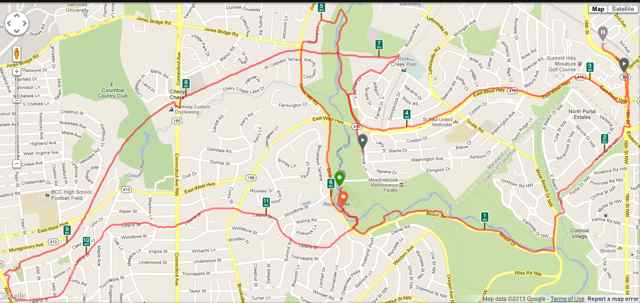 (click for larger map; see Garmin and iPhone Runkeeper GPS trackfiles) | A contrail bisects the sky as I come outside to meet Stephanie Fonda and hitch a ride to Candy Cane City. Our run begins at sunrise, 7:21am on this the first day of Daylight Saving Time. The trackfile makes a mutant-butterfly pattern, as we head first down Rock Creek into DC, then branch into Silver Spring to visit McDonalds where I snag a senior-discount coffee. Back along East-West Hwy I insist on a detour to visit the original boundary stone set in place in 1792 [1] to mark the northernmost point of DC. After a swerve north along Rock Creek we return to Stephanie's car for a shoe change, then add another five miles from Meadowbrook Stables via the Capital Crescent Trail to Bethesda and return along über-hilly Leland St. As we arrive at Candy Cane City Stephanie greets "Santa Steve" Schreuers. We cooldown-chat with him about training and upcoming races. Along the way is the usual superb conversation about friends, frustrations, families, and life. Stephanie tells me of a new self-experiment she's beginning: intermittent fasting. She knows before she mentions the topic that it will captivate me, since it combines: (1) the potential to run faster without extra effort (see Weight Management, etc.); (2) self-experimentation, my second-favorite activity; (3) evidence-based medicine; and (4) mindfulness an increased awareness of what otherwise is often, for me a thoughtless grazing (especially when I get home). Stephanie suggests that rather than fasting two entire days per week, perhaps more rational is to undertake 14-16 hours of non-eating most days — not including running race day, of course. |
- Wednesday, March 27, 2013 at 04:17:24 (EDT)
Physical exercise is its own reward. It doesn't matter if it gets recorded in a logbook or if anybody else sees you doing it. But of course, that doesn't stop me from quasi-obsessively keeping notes on my runs. And it certainly doesn't stop me from feeling a foolish pride when someone who knows me happens to see me pounding the pavement, especially at an outrageous location or time.
So in recent months I've received a bonus of joy when my former boss Pat Cook happens to be on his way in to the office gymnasium at 5:30am and spots me outbound with comrade Kristin Heckman for a pre-dawn trek. Pat is a retired FBI Special Agent with a dry sense of humor in addition to a serious work(out) ethic. One morning as we chat en passant in the men's locker room Pat teaches me a new phrase: "Executive Workout". It's his term for what certain senior colleagues used to do when they showed up hyper-early at the gym not to sweat but simply for a quick shower. They got seen in proximity to exercise machines, and then they got to their desks before most of their minions. All just for looks and boasting rights!
- Tuesday, March 26, 2013 at 04:30:46 (EDT)
~10 miles @ ~10.6 min/mi
A pack of friends starts from Ken-Gar at 0730, and when I get there at 0845 they're all out of sight. I head northward (upstream) as per plan and within the first half mile spy Jennifer Wieland, coughing horribly, escorted by Ken Swab as they return early. The rest of the gang appears a couple of miles farther north, when first Gayatri Datta and Sam (Samantha) Yerkes come into view, and some distance back of them Sara Crum, Rebecca Rosenberg, and Barry Smith. Barry is, like Jennifer, coughing but claims to be recovering. Back at Ken-Gar most are satisfied with their ~10 miles (I have only done ~5 so far) but Sara and Barry want more, so I trot southward with them to Cedar Lane and back, with side excursions for hillwork on the path up to the Ken-Gar neighborhood where Plyers Mill Rd ends. Runkeeper and Garmin concur to within a few percent.
- Monday, March 25, 2013 at 04:04:21 (EDT)
Jakusho Kwong's 2003 collection of talks No Beginning, No End: The Intimate Heart of Zen is quite reminiscent of Shunryu Suzuki's extraordinary books Zen Mind, Beginner's Mind and Not Always So. That's not surprising: Suzuki was Kwong's teacher and predecessor in a California Zen center. The parables and insights that Kwong offers are excellent, sometimes startlingly so. After a paragraph of background, for example, Chapter One commences with a disclaimer:
If you come to listen to a talk as if you are going to hear something great from somebody else, this is a big mistake. The word teisho means something you already intimately know, and it is during the teisho that the roshi makes the Dharma, or truth, come alive. So the Dharma talk is really going on twenty-four hours a day ... continuously, without interruption, realized or not. We should remember this. It's usually very near at hand, preciously close, and always with you.
That's imminence, the now and here of the present instant. Like being aware every time you cross a threshold, and realizing that every moment is the threshold between past and future. Not something that words can properly capture, but definitely something that words can point at, like a finger pointing at the moon. A little later in that same first chapter of No Beginning, No End Kwong sketches out the paradox of "nothing is happening":
... This illumination shines throughout your body, breath, and mind and dissolves your delusions based on greed, anger, and ignorance. And that's exactly how the light and the dark interact. ... And though, again, it is beyond our thinking or conceptual mind, there is an intimate connection here. This is Nothing is happening. No one can pinpoint exactly what, or where, or when. As you sit, you'll discover this for yourself, and you'll also discover that through your sitting practice you will develop some kind of stability in your life. There's something very deep and immovable in yourself that was always there ... the empty essence from which the whole universe springs forth.
Nonsense. Or maybe deep sense. More quotes and fragments to follow.
- Sunday, March 24, 2013 at 18:27:40 (EDT)
~3 miles @ ~10.5 min/mi
At 0530 I give Kristin Heckman the flashlight and she takes me on what she initially thinks is "Ed's Loop" but later realizes is missing a mile or so prelude. As we exit at the loading dock my former group leader Pat Cook is incoming, so I get to laugh about scoring some points in his eyes. Temps are near freezing and a last-quarter moon glows through thin clouds. The sidewalks and streets of McLean are quiet, and we chatter about family and health and a flock of chickens that roam Kristin's neighborhood. To add some mileage when re get back to our start at only ~1.8 on the GPS we try one circuit of the three-loop MITRE 5k route and it indeed appears to be a bit over 1.0 miles. At the end we're struggling to remember the term for blaming others but not oneself — Fundamental Attribution Error, cartographer friend Meredith later enlightens me. Runkeeper and Garmin concur, with splits approximately 11:07 + 10:12 + 10:04 min/mi descending in pace.
- Saturday, March 23, 2013 at 05:12:34 (EDT)
Leanne Shapton was a good swimmer, maybe a great swimmer — but not quite great enough to make the Canadian Olympic team when she competed in the 1988 and 1992 trials. Her book Swimming Studies is a good book, maybe a great book — if one can forgive a bit of distracting cuteness and a graphical design that sometimes intrudes on the stories. Shapton's artwork, at least as reproduced here, falls far short of her prose. But she's slick and sharp, fast and powerful.
Swimming Studies begins by looking into the rear-view mirror, in the chapter "Quitting", at the feeling of being near-elite:
I've defined myself, privately and abstractly, by my brief, intense years as an athlete, a swimmer. I practiced five or six hours a day, six days a week, eating and sleeping as much as possible in between. Weekends were spent either training or competing. I wasn't the best; I was relatively fast. I trained, ate, traveled, and showered with the best in the country, but wasn't the best; I was pretty good.
I liked how hard swimming at that level was—that I could do something difficult and unusual. Liked knowing my discipline would be recognized, respected, that I might not be able to say the right things or fit in, but I could do something well. I wanted to believe that I was talented; being fast was proof. Though I loved racing, the idea of fastest, or number one, of the Olympics, didn't motivate me.
I still dream of practice, of races, coaches, and blurry competitors. I'm drawn to swimming pools, all swimming pools, no matter how small or murky. When I swim now, I step into the water as though absentmindedly touching a scar. My recreational laps are phantoms of my competitive races.
In "Training Camp", a typical whiff of Shaptonian prose:
I lie on my side and wait for the weak wheeze of the fan to reach me. The hotel has given each room an oscillating upright fan and I'm the farthest away from it, behind Shelley, who smells like insect repellant and shampoo. The fan pushes fainter notes of chlorine, suntan lotion, and wet concrete around the room.
In Chuck Palahniuk's Fight Club "Slide" is all the emperor penguin says in the power animal cave. And that same "Slide" is at the center of Swimming Studies: a smooth, richly scented, present-tense slither down a chute toward total immersion in a scrapbook of Leanne Shapton's reveries. More quotes to follow.
- Friday, March 22, 2013 at 04:05:25 (EDT)
~4.9 miles @ ~15.2 min/mi
After yesterday's 50k the old legs need a recovery trek. Barry Smith and Rebecca Rosenberg lead an afternoon ramble from Candy Cane City into Rock Creek on the Western Ridge Trail, then back via the Valley Trail. It's chilly, windier than yesterday. Runkeeper and Garmin roughly concur on the distance and pace.
- Thursday, March 21, 2013 at 04:07:09 (EDT)
For back issues of the ^zhurnal see Volumes
v.01 (April-May 1999),
v.02 (May-July 1999),
v.03 (July-September 1999),
v.04 (September-November 1999),
v.05 (November 1999 - January 2000),
v.06 (January-March 2000),
v.07 (March-May 2000),
v.08 (May-June 2000),
v.09 (June-July 2000),
v.10 (August-October 2000),
v.11 (October-December 2000),
v.12 (December 2000 - February 2001),
v.13 (February-April 2001),
v.14 (April-June 2001),
0.15 (June-August 2001),
0.16 (August-September 2001),
0.17 (September-November 2001),
0.18 (November-December 2001),
0.19 (December 2001 - February 2002),
0.20 (February-April 2002),
0.21 (April-May 2002),
0.22 (May-July 2002),
0.23 (July-September 2002),
0.24 (September-October 2002),
0.25 (October-November 2002),
0.26 (November 2002 - January 2003),
0.27 (January-February 2003),
0.28 (February-April 2003),
0.29 (April-June 2003),
0.30 (June-July 2003),
0.31 (July-September 2003),
0.32 (September-October 2003),
0.33 (October-November 2003),
0.34 (November 2003 - January 2004),
0.35 (January-February 2004),
0.36 (February-March 2004),
0.37 (March-April 2004),
0.38 (April-June 2004),
0.39 (June-July 2004),
0.40 (July-August 2004),
0.41 (August-September 2004),
0.42 (September-November 2004),
0.43 (November-December 2004),
0.44 (December 2004 - February 2005),
0.45 (February-March 2005),
0.46 (March-May 2005),
0.47 (May-June 2005),
0.48 (June-August 2005),
0.49 (August-September 2005),
0.50 (September-November 2005),
0.51 (November 2005 - January 2006),
0.52 (January-February 2006),
0.53 (February-April 2006),
0.54 (April-June 2006),
0.55 (June-July 2006),
0.56 (July-September 2006),
0.57 (September-November 2006),
0.58 (November-December 2006),
0.59 (December 2006 - February 2007),
0.60 (February-May 2007),
0.61 (April-May 2007),
0.62 (May-July 2007),
0.63 (July-September 2007),
0.64 (September-November 2007),
0.65 (November 2007 - January 2008),
0.66 (January-March 2008),
0.67 (March-April 2008),
0.68 (April-June 2008),
0.69 (July-August 2008),
0.70 (August-September 2008),
0.71 (September-October 2008),
0.72 (October-November 2008),
0.73 (November 2008 - January 2009),
0.74 (January-February 2009),
0.75 (February-April 2009),
0.76 (April-June 2009),
0.77 (June-August 2009),
0.78 (August-September 2009),
0.79 (September-November 2009),
0.80 (November-December 2009),
0.81 (December 2009 - February 2010),
0.82 (February-April 2010),
0.83 (April-May 2010),
0.84 (May-July 2010),
0.85 (July-September 2010),
0.86 (September-October 2010),
0.87 (October-December 2010),
0.88 (December 2010 - February 2011),
0.89 (February-April 2011),
0.90 (April-June 2011),
0.91 (June-August 2011),
0.92 (August-October 2011),
0.93 (October-December 2011),
0.94 (December 2011-January 2012),
0.95 (January-March 2012),
0.96 (March-April 2012),
0.97 (April-June 2012),
0.98 (June-September 2012),
0.99 (September-November 2012),
0.9901 (November-December 2012),
0.9902 (December 2012-February 2013),
0.9903 (February-March 2013),
0.9904 (March-May 2013),
0.9905 (May-July 2013),
0.9906 (July-September 2013),
0.9907 (September-October 2013),
0.9908 (October-December 2013),
0.9909 (December 2013-February 2014),
0.9910 (February-May 2014),
0.9911 (May-July 2014),
0.9912 (July-August 2014),
...
Current Volume.
Send comments and suggestions to z (at) his.com. Thank you! (Copyright © 1999-2013 by Mark Zimmermann.)















